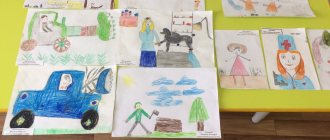Work assignments in the senior group. Card file with goals according to the Federal State Educational Standard
Card index of work assignments in the senior group of the preschool educational institution
“Cleaning up toys in place” Goal: to improve the ability to independently maintain order in the group (cleaning up building materials, toys). To cultivate aesthetic taste and the desire to work for the benefit of others. “Order in the closet with toys” Purpose: to teach children to independently and aesthetically arrange toys, maintain order in closets, and wipe dust. Develop hard work and the ability to see disorder. To cultivate aesthetic taste and the desire to work for the benefit of others. “Helping the nanny” Goal: To teach how to clear dishes from tables after meals, to teach children to provide all possible assistance to adults. Develop hard work and a desire to help adults. Foster respect for the work of adults. “Canteen duty” Purpose: independently and conscientiously perform the duties of a duty officer; wash your hands thoroughly, put on the clothes of the person on duty, set the table correctly, put away the dishes after eating. Develop labor skills and abilities, the ability to see disorder in the table setting. Cultivate a desire to work for the benefit of others. “Duty for classes” Purpose: independently and conscientiously perform the duties of a duty officer: lay out materials and aids prepared by the teacher for classes on tables; wash and put them away after class. Develop hard work and a desire to help adults. Cultivate a desire to work for the benefit of others. “Order in toys” Purpose: to teach children to put on work aprons before starting work; keep toys in order: wash, dry, wipe and put in place. Develop hard work and the ability to see disorder; be careful when working with water. Cultivate a desire to work for the benefit of others. “Duty in a corner of nature” Goal: to improve the ability to independently care for indoor plants: watering, loosening the soil. Foster a sense of responsibility. Learn to follow safety and personal hygiene rules. “Clean flower trays” Purpose: to teach children to observe hygienic skills when working with water: roll up their sleeves, wet a cloth and wring it dry, rinse when dirty. Develop labor skills and habits, accuracy when working with water. Cultivate a desire to work. Learn to follow safety and personal hygiene rules. “We wash napkins” Goal: teach children the skills of soaping, rinsing and wringing out napkins, and continue to build a work culture. Develop hard work and the ability to see disorder; be careful when working with water. Cultivate a desire to work in a team, in harmony. “Order in the dressing room closet” (together with an assistant teacher) Purpose: to teach children to maintain order in their personal wardrobes: empty the closet of clothes and shoes, wipe the shelves with a damp cloth, and neatly put the clothes back in place. Develop diligence, the ability to see disorder, and accuracy when working with water. Cultivate a desire to work in a team, in harmony. “Repairing books” Goal: to teach children to peck at books, use glue and scissors correctly, and use napkins. Develop labor skills, eye, fine motor skills, creative imagination. Foster a desire to work for the benefit of others, treat books and toys with care. “Clean chairs” Purpose: to teach children to keep the chairs in the group room tidy and clean: wipe them with a damp cloth; arrange in places after classes. Develop labor skills and abilities, the ability to comply with cultural and hygienic requirements when working. Cultivate a desire to help adults and respect for their work. “Washing doll clothes” Purpose: To teach children to help the teacher in washing doll clothes and bedding: to teach children to put on work aprons before starting work; prepare the necessary supplies for washing and drying, as well as a workplace; know how to use soap. Develop labor skills and abilities, the ability to comply with cultural and hygienic requirements when working. Cultivate a desire to work for the benefit of others. “Washing dolls” Purpose: To teach children to help the teacher in washing dolls: rinse soaked dolls, clean them with brushes. Develop diligence, the ability to see disorder, and accuracy when working with water. Cultivate a desire to help adults and respect for their work. “There is order in the closet” Purpose: To teach children to be neat when folding things in the outerwear cabinet. “Changing towels” Goal: To develop a desire to work, to be able to offer help. “Helping the nanny in arranging bedding on the beds” Purpose: To teach how to sort bedding by belonging, to cultivate a desire to help the nanny and respect for other people’s work. Cultivate a desire to work, a sense of responsibility for the assigned work. “Let’s arrange the chairs in a certain order” Goal: Continue to develop work skills; carry out the assignment carefully, quickly, diligently. “Cleaning up building material” Purpose: To teach how to wash, dry and lay building material, to teach children to constantly and promptly maintain order in the play corner, to wash building material with a soapy solution prepared by the teacher, to rinse it, and to dry it; observe the rules of personal hygiene.
We recommend watching:
Labor education in kindergarten Labor education in kindergarten Labor education of preschool children Summary of a lesson on labor education in the younger group
Similar articles:
Instilling responsibility in organizing the work activities of preschool children
Summary of a lesson on labor education in the preparatory group. Inventions and achievements of man
Card file for a corner of nature in the middle group
Card index: Labor in nature. Pre-school group.
Watering indoor plants.
Goal: Teach children to care for indoor plants; water from a watering can
water at room temperature; consolidate children's knowledge about different methods of watering indoor plants. Develop accuracy when working with water and plants, confidence in your actions, work skills. Foster a caring attitude towards the natural environment and a desire to take care of it.
Loosening the soil of indoor plants.
Goal: Teach children to care for indoor plants; give children knowledge about why it is necessary to loosen the soil of plants; consolidate loosening techniques and rules for using the necessary items for this. Develop labor skills, accuracy. Foster an ecological culture and respect for the environment.
Spraying indoor plants.
Goal: To teach children to provide all possible assistance to the teacher in caring for indoor flowers: spray the plants with water at room temperature, use the sprayer correctly. Develop labor skills and habits, accuracy when working with water and plants. Foster an ecological culture, a caring attitude towards the natural environment, and a desire to take care of it.
Caring for large-leaved plants (wet wiping of leaves).
Goal: To teach children to provide all possible assistance to the teacher in caring for indoor flowers: wipe large leaves of plants with a damp cloth, being careful. Give children the knowledge that this method of care makes it easier for plants to breathe, which determines their growth and development. Develop labor skills and habits, accuracy when working with water and plants. Foster an ecological culture, a caring attitude towards the natural environment, and a desire to take care of it.
Caring for plant leaves (removing dust with brushes and a dry cloth)
Goal: To teach children to provide all possible assistance to the teacher in caring for indoor flowers: remove dust from plants with brushes or dry cloths, being careful. Give children the knowledge that this method of care makes it easier for plants to breathe, which determines their growth and development, and improves their appearance. Develop labor skills and habits, accuracy when working with water and plants. Foster an ecological culture, a caring attitude towards the natural environment, and a desire to take care of it.
Plant cuttings.
Goal: To clarify children’s knowledge of what a plant can be grown from.
Teach children how to properly plant a plant cutting, prepare the soil, care for them and the sequence of work: pour sand into the bottom of the pot, then soil, water, wait until the water is absorbed into the sand, make a hole in the middle (center) of the pot with a stick and plant the cutting until the first leaf, press the ground. Water as needed. Develop labor skills and habits, accuracy when working with water and plants. Foster an ecological culture, a caring attitude towards the natural environment, and a desire to take care of it.
Replanting indoor plants.
Goal: To teach children to provide all possible assistance to the teacher in replanting plants; teach plant transplantation techniques and sequences
work: choose the right size pot, prepare sand and soil, plant. To consolidate children's knowledge about indoor plants and their differences from each other. Develop labor skills and habits, accuracy when working with land, water and plants. Foster an ecological culture, a caring attitude towards the natural environment, and a desire to take care of it.
Planting onions on the windowsill.
Goal: To teach children to set a goal, prepare a workplace, tools and clean up after themselves. To consolidate children's knowledge about the structure of the onion and the conditions necessary for onion growth. Develop labor skills and habits, accuracy when working with land, water and plants. Foster an environmental culture, a desire to achieve results, and participate in a common cause.
Sowing flower and vegetable seeds.
Goal: To give children knowledge that every plant has seeds. Learn the sequence of actions required when sowing seeds; make a hole in the soil (for sowing seeds, marking each time with a stick
the distance between them and grooves for small seeds; teach to observe cultural and hygienic skills when working. To consolidate children's knowledge about at what time, which seeds are sown in boxes in a group for preparing seedlings, and which seeds are sown in open ground. Develop labor skills and abilities. Foster an ecological culture, a caring attitude towards the natural environment, and a desire to take care of it.
Planting seedlings and caring for them.
Goal: To form children’s ideas about the main stages of plant growth and development (seed, seedling, stem with leaves); about the basic methods of growing plants and caring for them (planting in loose soil, watering, loosening the soil, weeding, feeding). Be careful when planting seedlings, as the plants are very fragile. Develop labor skills and habits, accuracy when working with land, water and plants. Foster an ecological culture, a caring attitude towards the natural environment, and a desire to take care of it.
Digging up beds.
Purpose: To give children an idea of the need to dig up a bed.
Teach proper digging: try to stick the shovel (bayonet) deeper, carefully break up the lumps; old plant roots and stones need to be removed from the beds.
Develop labor skills and abilities, the ability to observe cultural and hygienic habits when working with the land. Foster an ecological culture, a caring attitude towards the natural environment, and a desire to take care of it.
Weeding the beds on your site and the children's site.
Goal: To teach children to distinguish a cultivated plant from a weed; pull out weeds by the roots, because if the root is left the weed continues to grow;
Give children some knowledge about the harm weeds cause to flowers and vegetables. Develop labor skills and abilities, the ability to observe cultural and hygienic habits when working with the land. Foster an ecological culture, a caring attitude towards the natural environment, and a desire to take care of it.
Watering flower beds and beds.
Purpose: To give children an idea of the need to water and care for plants in beds and flower beds. Involve children in watering plants from a watering can with water at room temperature.
Develop accuracy when working with water and plants, confidence in your actions, work skills.
To cultivate a caring attitude towards the surrounding nature, a desire to take care of it, and an ecological culture.







